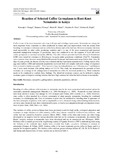| dc.contributor.author | Kimenju, J. Wangai, | |
| dc.contributor.author | Maundu, J. Nzesya | |
| dc.contributor.author | Muiru, W. Maina, | |
| dc.contributor.author | Wachira, M. Peter, | |
| dc.contributor.author | Gichuru, K. Elijah | |
| dc.date.accessioned | 2014-07-03T11:33:59Z | |
| dc.date.available | 2014-07-03T11:33:59Z | |
| dc.date.issued | 2014 | |
| dc.identifier.citation | Wangai, K. J., Nzesya, M. J., Maina, M. W., Peter, W. M., & Elijah, G. K. (2014). Reaction of Selected Coffee Germplasm to Root-Knot Nematodes in Kenya. Journal of Natural Sciences Research, 4(3), 68-75. | en_US |
| dc.identifier.uri | http://iiste.org/Journals/index.php/JNSR/article/view/11066 | |
| dc.identifier.uri | http://hdl.handle.net/11295/71753 | |
| dc.description.abstract | Coffee is one of the most important cash crops in Kenya and a leading export earner. Nematodes are among the most important biotic constraint in coffee production in Kenya and crop improvement work has mainly been breeding for resistance to diseases such as coffee berry disease and coffee leaf rust. However resistance has been used successfully in other coffee producing countries and it is one of the most economical and practical nematode management strategies. A greenhouse study was conducted to test the response of local and exotic coffee germplasm to root knot nematodes (RKNs). Ten (10) cultivars provided by Coffee Research Foundation (CRF) were tested for resistance to Meloidogyne incognita under greenhouse conditions (25±2oC). Nematodes were extracted from the roots using Modified Baermann Technique and enumerated using Cobbs slide. After 90 days of plant growth, the disease severity was evaluated and the experiment repeated twice. Galling indices (GI), egg mass indices (EMI) and nematode populations recovered from soil samples indicated a range of responses from resistant to highly susceptible. Three breeder’s lines including Robusta tree 1, Robusta tree 2 and Robusta tree 3 were rated resistant with galling indices of 1.2-3.0. This study has demonstrated the potential of host resistance as a strategy in the management of nematodes in coffee for increased productivity. Field evaluation needs to be conducted to confirm these findings. The identified resistance sources can be utilized to deploy resistance genes to improve existing varieties that have high commercial value but lack resistance to nematodes.
Key words: Resistance, susceptible, galling indices, nematode population, cultivars | en_US |
| dc.language.iso | en | en_US |
| dc.title | Reaction of Selected Coffee Germplasm to Root-Knot Nematodes in Kenya | en_US |
| dc.type | Article | en_US |


